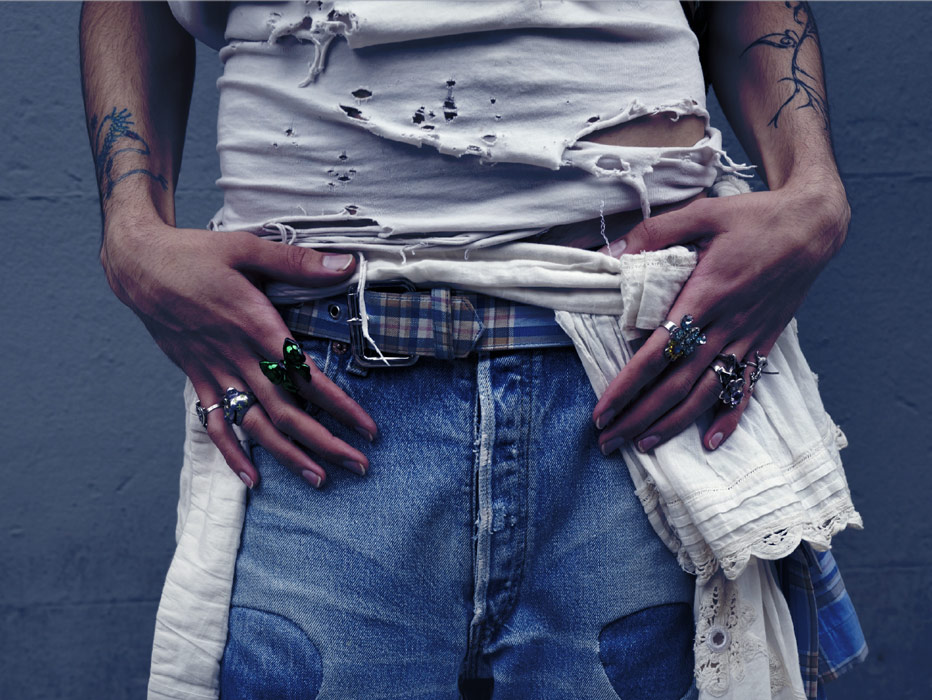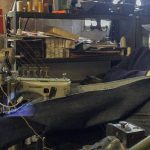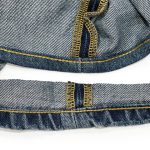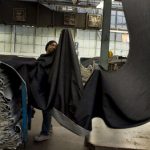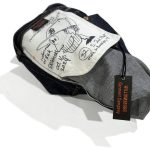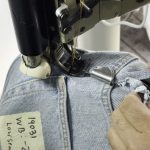Saturday, September 27, 2025🕚 11:00 AM – 6:00 PM📍 59 Orchard Street, Lower East Side, NYC If you’re a fan of vintage denim, creative customization, and the culture surrounding rugged American workwear, Denim Edition might be the best denim show you’ll attend
Read More →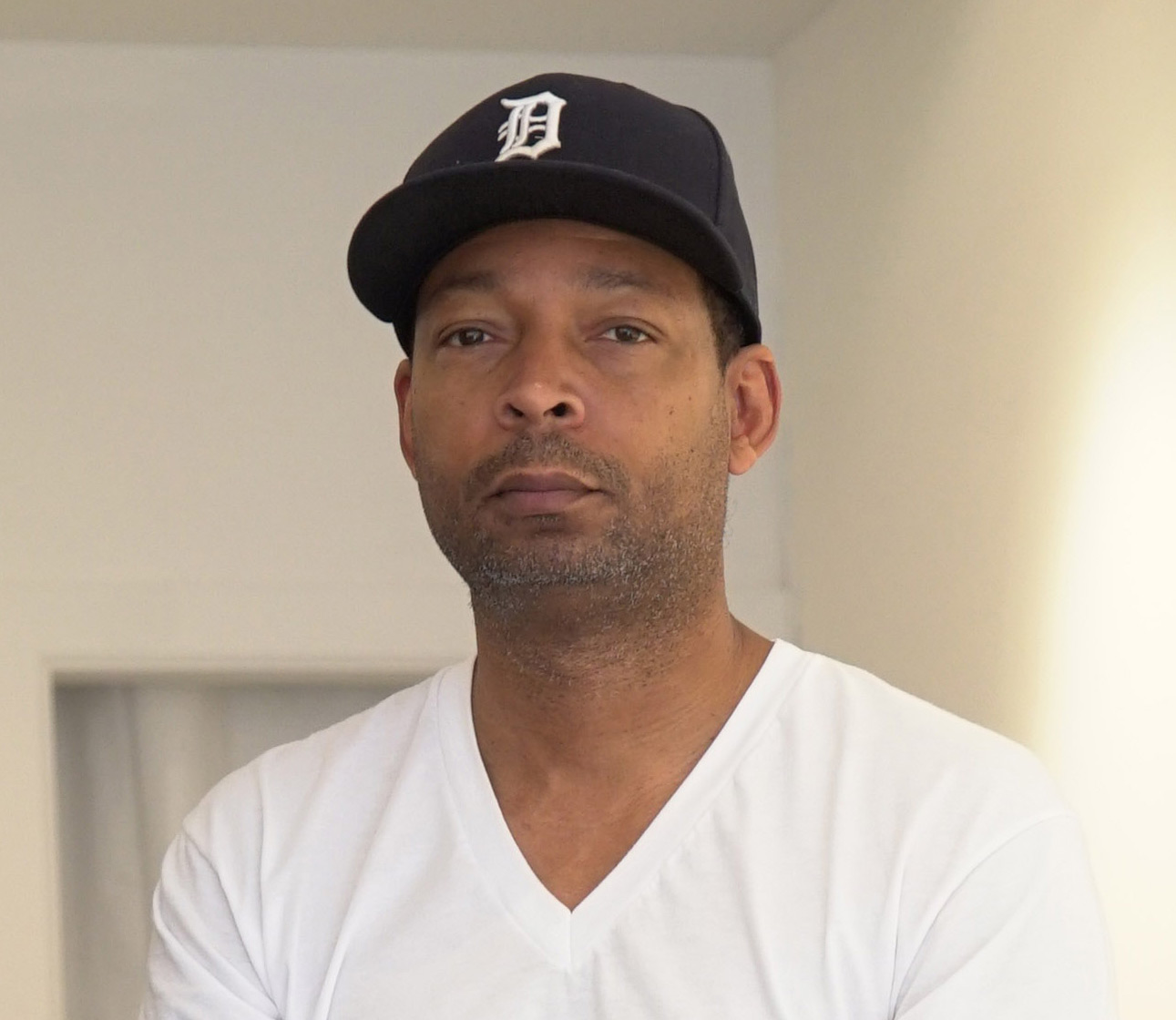
The easiest way to go out of business is to be too big or expand too fast, according to Maurice Malone, the denim designer at Williamsburg Garment Company (WGC). The company has grown by staying small and maximizing its efforts. He advises upcoming American manufacturers to run a smart, small and tight business, built to do business today, not yesterday.
WGC, a one-man company, moved its production from China to the US following former President Barack Obama’s call to bring manufacturing back to the US.
“When our first American-made jeans proved very successful retailing at only a few dollars more than before, I knew the bulk of our customers would gladly pay a little more for American jeans over imported ones. So, I moved all WGC production to the US later that year,” Malone told Fibre2Fashion.
The company plans to expand into knit garments and core wardrobe essentials like t-shirts, sweatshirts, joggers, leggings, and socks this year. It will also be moving most of its production in-house.
Talking about what sets WGC’s denim apart from its competitor’s jeans, he said, “What makes us the same is what sets us apart. We use the same fabrics as most of our American-made brand competitors while having better or equal quality in sewing and construction. I mean, there are only so many ways you can sew a seam and we try to use the best techniques that garner the best result for the design or style. Then we apply a high level of attention to the details.” (KD)
The interview
Q. What inspired you to make jeans in the United States of America?
A few things led me to move my production from China to the United States of America. Working for many years in China, I watched how they used manufacturing to help the growth of their economy. After conversations with my friend who owned the factory in which my clothing was made in China, I realized that if I sacrificed a little individual gain for the greater good, I could be a small part of helping to bring American garment manufacturing back to the country.
So, when President Barack Obama asked companies to bring manufacturing back to the United States of America, I answered the call and named our first American-made jeans Hope Street in honor of the President. It also happens to be a street in Williamsburg.
When our first American-made jeans proved very successful retailing at only a few dollars more than before, I knew the bulk of our customers would gladly pay a little more for American jeans over imported ones. So, I moved all Williamsburg Garment Company (WGC) production to the United States of America later that year.
Q. What is the growth story of WGC?
During the slump in the economy near the end of the Bush years, I could not find investors for the brands I wanted to launch. I was laid off after having a job for a short time and could not find work. I was amazed that someone with my talent, capable of doing any job at a clothing company, could not get hired.
I freelanced to save money to start my own venture. When I started WGC, I wanted to inspire other designers and entrepreneurs and prove that one person using the technology of the day can build and operate a major internationally known brand.
I started the brand going the traditional wholesale, tradeshow route but had my eye on the future, which I believed was direct to consumer via e-commerce. I got the jump by building a powerfully optimized low-cost website that outperformed big expensive websites that focused on looks instead of being found through search optimization. As my direct-to-consumer business grew, I found no time to chase less profitable wholesale to retailers. Today, although I still sell to retail stores, I do it only if buyers contact me. I no longer call on stores or do tradeshows. I just do not have the time.
Q. What are the advantages and disadvantages of running a one-man show?
The disadvantage is with time. I found myself constantly optimizing everything I do, yet there is still only so much time in a day. After nearing the ceiling or topping out, I got help.
The advantage is, that you are in direct, unfiltered contact with consumers, which helps you understand the relationship between your buyers and products. This helped me build a strong base for the company. That is important for growth. Knowing who you are, what you do, and who you are marketing gives you a strong foundation to stand on.
As the designer of a one-man company, people often ask me how I spend most of my time. My answer is, that most of my time is spent working on my website, optimizing, updating, and writing content because the site is the engine that drives my sales. The next large chunk of time is used answering emails, customer service, marketing/online advertising, and shipping. Then comes accounting, general maintenance, and finally, production and design. Optimizing production and design early help me to spend less time on it today with occasional tweaks here and there.
Q. What sets your raw denim jeans apart from those of your competitors’?
What makes us the same is what sets us apart. We use the same fabrics as most of our American-made brand competitors while having better or equal quality in sewing and construction. There are only so many ways you can sew a seam and we try to use the best techniques that garner the best results for the design or style. Then, we apply a high level of attention to detail.
The biggest separator then becomes our price and branding. Many like to claim fit is the deciding factor, but when you make so many fits, it is likely someone has a fit close to yours. So, when you add all the above, we are priced well below most American-made brands that meet us in quality and fit. It is our pricing or the way we lack branding, which is the biggest thing that sets us apart. You can buy jeans made in the United States of America cheaper from Kickstarter-type brands but then you end up waiting months to get the product and quality could be an issue. This is the sweet spot. Many of our customers want moderately priced, great quality, branded American-made jeans without the wait.
The last factor is branding. Most jeans are branded on the outside while we brand ours on the inside. We simply give a classic, clean product without a lot of extras.
Q. What is your take on new blends and colors in a denim industry that has also seen the rise of jeggings?
I would like to see us do more printed fabrics, especially for the summer months.
Q. Which is the one style of jeans that can never go out of date?
With the growth of the Internet and so many people seeing so many things, style is no longer driven by any industry. People all over the world can find what they are into and it is likely that someone offers that. So, I think the days of things going in and out of style are over. That said, the standard straight-leg jean is the most timeless fit when it comes to denim. Fits trend and descend in popularity, but the basic straight has stood the test of time. At WGC, we strive for tradition. The major philosophy behind this brand is to not to give the consumer a reason to say no. We stripped our jeans of everything that may turn people away because clean and classic will last forever.
Q. Which brands in the United States of America provide the most authentic true blue jeans?
Someone who is not knowledgeable about denim would think the oldest brands would be the obvious choice. They do not realise that these brands are now mainly producing jeans not made in the United States of America. Obviously, we are a bit biased, but WGC is one of the few brands that offers modern, wearable jeans of top quality with fits that appeal to all consumers.
Q. How has the market for jeans evolved in the United States of America? What are your views on the current market?
Denim remains an essential part of people’s wardrobe. Leggings have taken a good portion of denim away in the women’s market while joggers have done the same to a lesser effect in the men’s market. However, more men find clean, dark denim more suitable for business casual wear. As far as style, I don’t see skinny going anywhere but I do see more people opting for loose fits as an alternative look.
Q. With Made in USA back in trend, what is the growth story you envisage?
We plan to be a top maker of US denim in the world, the brand everyone thinks of when thinking of American denim. We have grown by staying small and maximising our efforts. The easiest way to go out of business is to be too big or expand too fast.
Q. At what rate is the jeans market growing in the United States of America? What are your expectations from it for the next two years?
I am not a researcher to give you market numbers but I can give historical facts. Denim will be strong in the foreseeable future, just like it has been in the past.
Q. From where do you source raw material?
Our denim is sourced from three main suppliers. About 92 per cent is from Cone denim which is made in the United States of America, about five per cent from Kuroki while three per cent is Kaihara denim, made in Japan.
Q. What is your manufacturing capacity?
Our factory is just starting. Our goal is to produce the WGC collection and start small with other brands to give us time to learn, perfect and optimise our production process.
Q. What are your plans for the company this year?
This year, we are expanding into knit garments and core wardrobe essentials like T-shirts, sweatshirts, joggers, leggings and socks. We are moving most production in-house. Too many times, suppliers we relied on fell way behind with delivery timelines, which makes us look bad to our customers. Our slogan is: We have a clear, focused vision: To be the world’s favourite American Denim Brand.
That cannot be achieved with late deliveries. We now have our own manufacturing arm. We intend to grow and market the new manufacturing company the way it should be done in today’s market.
Q. How much do you invest in R&D every year?
We do not waste much money on R&D. Timelines are short and experimenting can be expensive. We have ideas and take them into production, starting small and safe with new products.
Q. How has the performance of your company been this fiscal? At what percentage are you expecting to grow in the next fiscal?
We have seen a small percentage growth each year. I believe the company has nearly topped out in numbers it can reach as a one-man company, so I have taken on help this year. Our growth now is only limited by our credit limits. In the current banking situation, we have seen credit lines grow slower than anticipated, so part of my focus this year will be to look for financial institutions that will work with our company to help us maximize our potential.
Q. Any suggestions for those planning to manufacture and sell items in the United States of America?
Run a smart, small and tight business. Start a business built to do business today, not yesterday.
You might be interested in
With the plethora of DIY hack videos out there, I thought it was crucial to show the proper method.
This video, which we posted on Instagram and TikTok, walks you quickly through our chain stitch hemming procedure.
I fell in love with the taste of coffee as a very young child
America’s leading supplier of high-quality denim fabrics since 1891, closing its 112-year-old White Oak Plant in Greensboro, North Carolina.
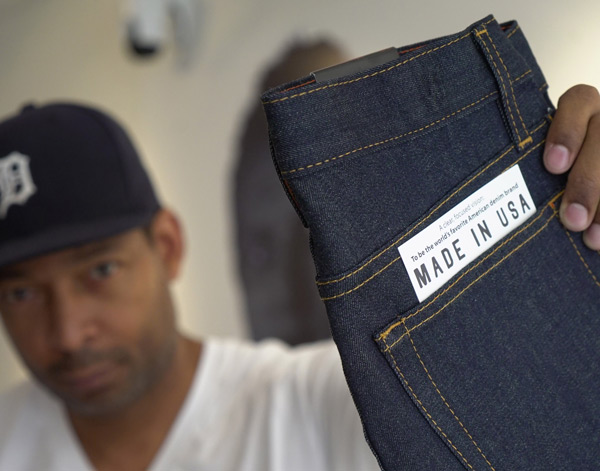
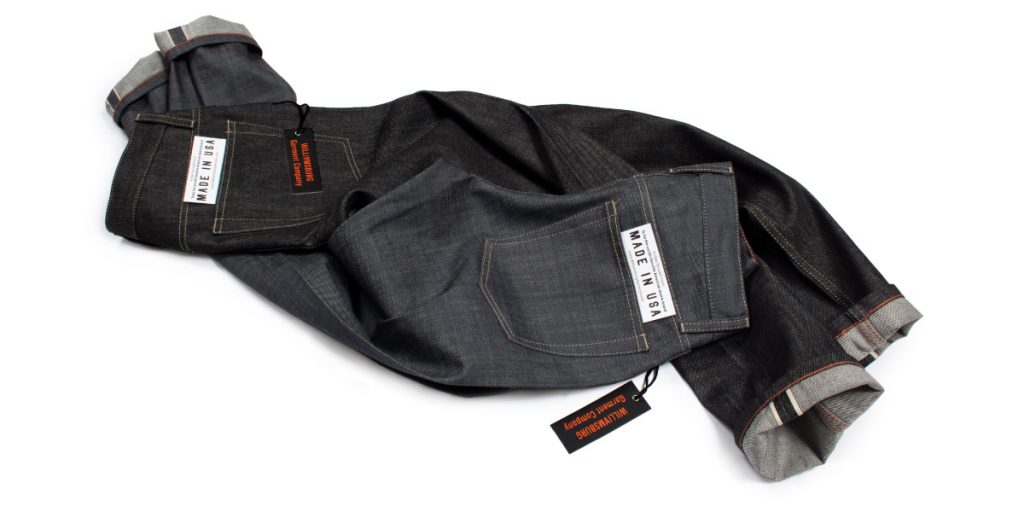
Automation and foreign production didn’t erode the American garment manufacturing industry, we did it to ourselves. When you think about it, the goal of corporations is to maximize profits for their investors. Contrast this against the Chinese philosophy of keeping people working by sacrificing high profits per piece in exchange for larger volumes at smaller margins.
As consumers seek lower-cost products, companies move production to lower-cost areas to stay competitive. Oftentimes, consumers become angered with higher-priced domestically made products when compared to those made in low-wage countries. This happens even if people want to see products made in America. In economics, they use the multiplier effect to measure the circular flow of money and spending in a community. Money that is earned flows from one person to the other. From the factory workers’ paycheck to the businesses where they shop and into the paychecks of employees at those businesses. The output becomes larger than the input. Conversely, when a factory closes its doors, less money is spent in the surrounding community reducing output from surrounding businesses which also negatively affects the line of suppliers. It all starts with the consumer’s decision to buy American or buy cheaper.
Why has manufacturing moved overseas?
Americans almost always choose to buy cheaper over buying made in the USA. This is why producers not claiming the luxury sector must find ways to streamline the production process and offer a better product at competitive prices – as is our goal.
One of the most inspirational things ever told to me in this business was from a friend who owned a small factory in China that produced our very first Williamsburg jeans. While I was in Guangzhou working for another brand, my friend, who was the production manager at a large factory told me he was about to open his own small place and asked. “Malone, why don’t you start a new brand that sells at very low prices? I’m sure you can sell a lot of jeans.” I said, “no, I’m not interested in making low-end products.” I asked him, “wouldn’t you rather make better quality at smaller volumes and earn a $20 profit per jean?” He responded “no, I’d rather make a hundred thousand jeans and make $1 profit per jean. This way I keep my people working and fed.” I laughed and said, “that would never work in the U.S.” It was not until later that I realized that was the kind of sacrifice and thinking which helped make China the number one producer of the world’s goods.
When we launched the Hope Street jean, our first American-made jeans, our imports were retail priced between $105 to $116. We were making a great profit at those prices and could offer retailers attractive markups at wholesale. After producing the Hope Street jeans near the retail price ($124) of our highest-priced imported jeans, I had confidence, that if given the choice, people would choose to pay a little more for better quality American-made jeans. Thus, we began the movement to make all of Williamsburg’s clothing in the USA.
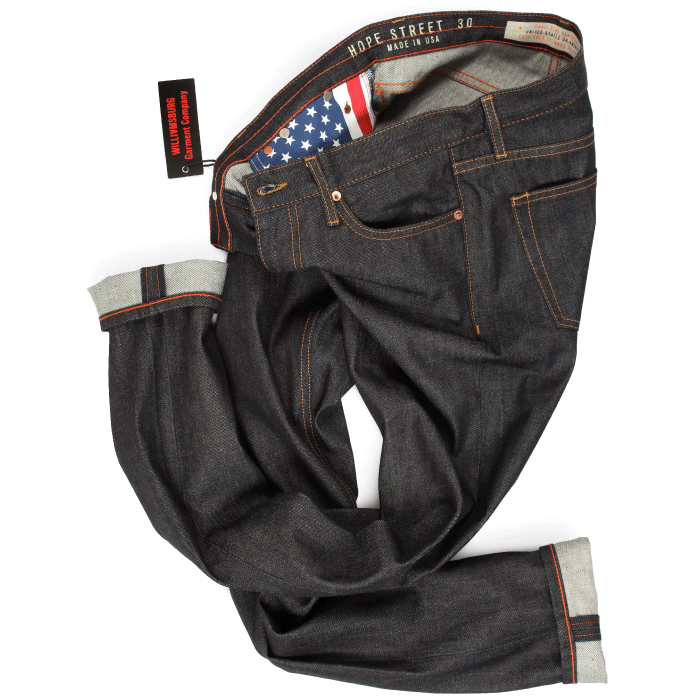
Where there’s a will there’s a way.
It was not easy to get our cost down to where we could meet the retail price goal. Compared to import production, there is more work, logistics, travel, and time put into producing jeans in the USA. Although it may not seem to make total financial sense, to me it has long-term worth. It began with making a 1-man company even savvier with cost and overhead.
Before opening our first retail store in 2016, the office was a small rented self-storage space. We had an electric outlet, no heat or air, and used a phone over the internet together with a mobile hotspot to connect to the world.
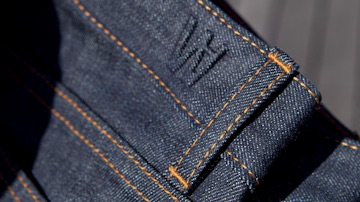
A good example of working down cost, take our small embossed W-logo on our waistband. Domestic producers that I met with wanted $2 to 4 per jean, with $1200 – $1500 upfront die cost. That was too much. The waistband logo itself could have ended up being about 14% of the total product cost. Instead, I shipped waistband fabric parts to China and had them embossed for 15 cents each, plus the shipping cost and we were off and running. By the third production of the Hope jeans, I was able to find an American-made machine that could emboss the waistband logo in production. The machine together with shipping was a little over $5500. I figured it was a good investment because it cost nearly the same as four productions from the quoting suppliers. With a little more homework, I located a local company to make our dies for less than a hundred dollars – a far cry from $1200 – $1500. Later, I worked out a new price and agreement with the owner of the sewing factory, handing him the local logistics responsibilities. This saved us tremendously because we avoided regular traveling expenses associated with doing production in Los Angeles from New York, which included rental cars, lodging, flights, etc.
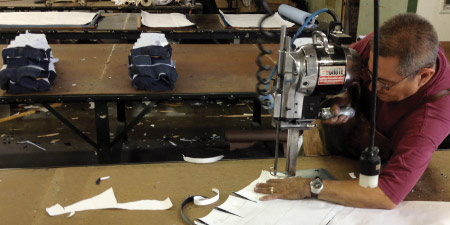
As the owner of a small business, I fully understand the value of finding vendors that will work in small volumes and invoice at higher volume production rates. High minimums and prices have prevented even established brands like ours from expanding and producing other products in the U.S. Aiming to reverse the snowball effect, we believe that starting small and developing our own production chains within The United States will help reverse the outflow. For consumers, our goal as manufacturers must be to produce reasonably priced, completive goods. Unlike those who find it convenient to say, “you can’t make that in the United States,” we believe in “where there’s a will, there’s a way.” We are small now but know as we grow, we will be part of building a stronger supply chain.
Our big brand competitors, if they choose to make the investment, could easily find pieces in their collections that could be produced in the U.S. or manufactured using their own or cooperative U.S. facilities. However, in corporate America, where more often it is profit over people, I believe it is unlikely. Still, we are hoping more companies will join us and choose to come back to the USA.
The rebuilding of American manufacturing has already begun thanks to small companies like ours. Williamsburg Garment Company will be ambitiously continuing to do our part to drive infrastructure development as we expand into sewing new knit products in-house, in Spring / Summer 2017. As we perfect our manufacturing process, we plan to also produce for other small and mid-sized brands, just as we do in denim. It is an uphill battle but we believe in becoming our slogan, “The world’s favorite American denim brand.”
You might be interested in
With the plethora of DIY hack videos out there, I thought it was crucial to show the proper method.
This video, which we posted on Instagram and TikTok, walks you quickly through our chain stitch hemming procedure.
I fell in love with the taste of coffee as a very young child
America’s leading supplier of high-quality denim fabrics since 1891, closing its 112-year-old White Oak Plant in Greensboro, North Carolina.
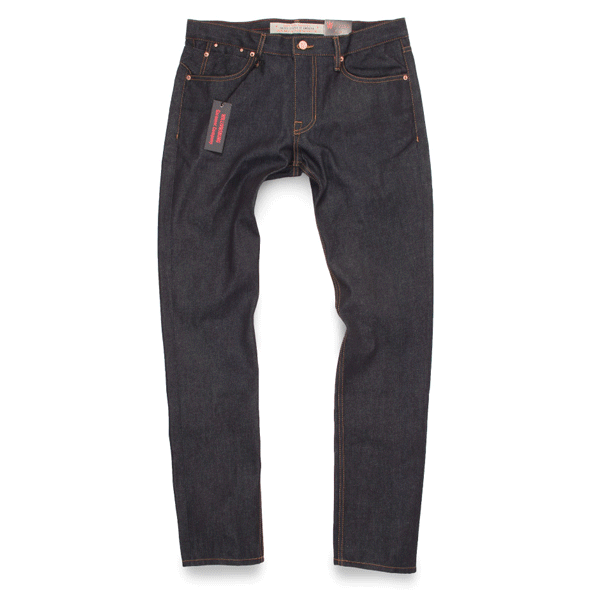
The noted changes in each stage are based on the measurement differences from the original unworn new jeans. For example, the waist growth from the unworn raw jeans in Stage-1 to the jeans that have been worn but never washed is +1″.
Stage 2, after the jeans have been worn for several months without a wash, they finally go through the pair’s first wash. The jeans are at their smallest point because they have not yet been worn again and seem to have lost at least a size. The waist now measures -1″ smaller than the original unworn new jeans at this point. Overall, that’s a 2″ difference between the waistband’s largest recorded size after the jeans were worn several months in the raw state and the first wash.

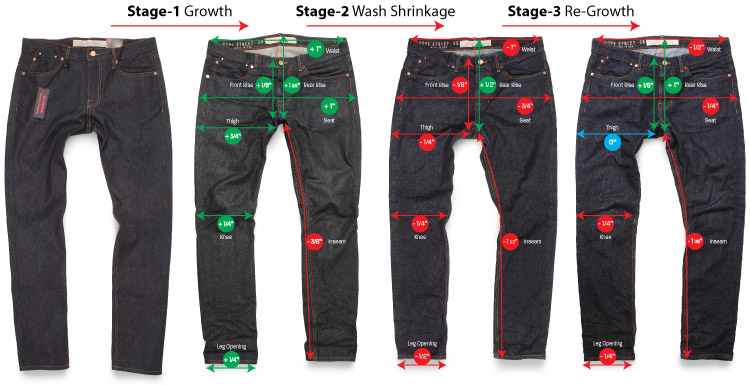
You might be interested in
You may have tried learning through YouTube or social media videos—but when you’re serious about mastering a craft, you quickly
If you’ve ever typed how to take in the waist of jeans into Google, you’ve probably seen a lot of
The first brand in our new lineup was TCB Jeans, a company out of Kojima, Japan that builds its reputation
The leg opening measurement is a critical factor in how your jeans fit over your shoes and shape your overall
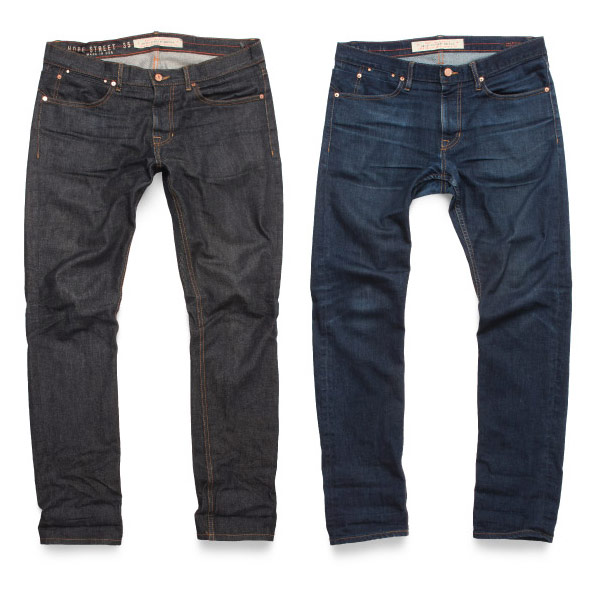
Which jean looks to be the oldest or most frequently worn jean? Is this a trick question, or do the photos state the obvious?
Since I launched Williamsburg Garment Company, I’ve worn nearly all the men’s styles and like most people, do have my favorites, of which, some jeans get worn more frequently than others. Some time ago, because wash factories often lose my oldest, most beat-up favorite jeans when I use them as samples to create new experimental natural-looking washes, I promised myself to start recording measurements, fading, shrinkage, and the growth of my jeans to share key insights to how each style preforms throughout the years before they disappear. This is part 1 of what will be at a minimum, a 2-part series, where I review the Hope Street standard raw vs. Grand Street stretch selvedge jeans.
I once received an email from the U.K. and the customer asked, “how long should it take for my jeans to fade?” He explained, that he wore his jeans very often for several months and they seemed to experience no fading, so he wanted to know if that was normal in our jeans. I replied no, saying the jeans should be showing signs of fading. I asked all the usual questions to make sure he was not doing something wrong and that he did indeed have one of our jeans. Nothing seems wrong and I thought it was one of those random odd emails and forgot about it. Then one day after thinking about how dark my Hope Street jeans were, even after more than a year of routinely performing heavy warehouse work in them, it bought me back to that email.
My standard raw Hope Street jeans still looked as dark as they did when they were new. Except for the stretch marks and crease lines that developed. I recalled that I had other jeans that were worn for less time that was more faded, which drove me to write this article.
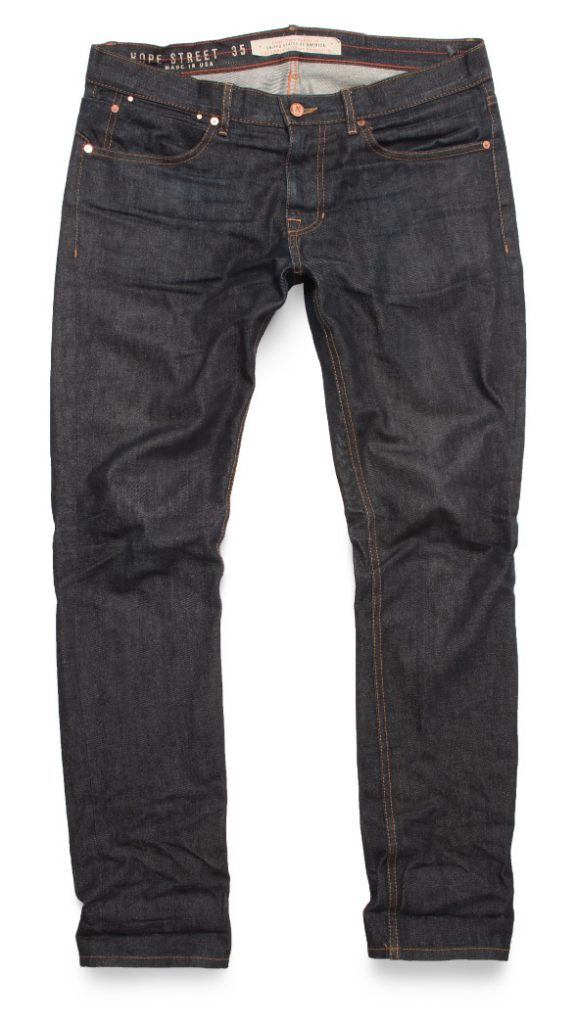
Right away, I compared them to the stretch selvedge Grand Street jeans, which I treated similarly, often wearing because of the high level of comfort. Between the two, there was an obvious extreme difference in the pace of fading. The stretch selvedge jeans are one of my recently developed styles, so they are not very old, yet they look older than the Hope jeans and others in my regular rotation of denim.
The stretch selvedge jeans in this photo have been washed once, while the Hope raw jeans have not. That’s because once a jean starts developing whiskers (the stretch marks at the hips) and showing signs of aging, I get anxious to accelerate the process with washing. That’s just me. However, the selvedge jeans are a lot younger with far less wear than the raw denim jeans.
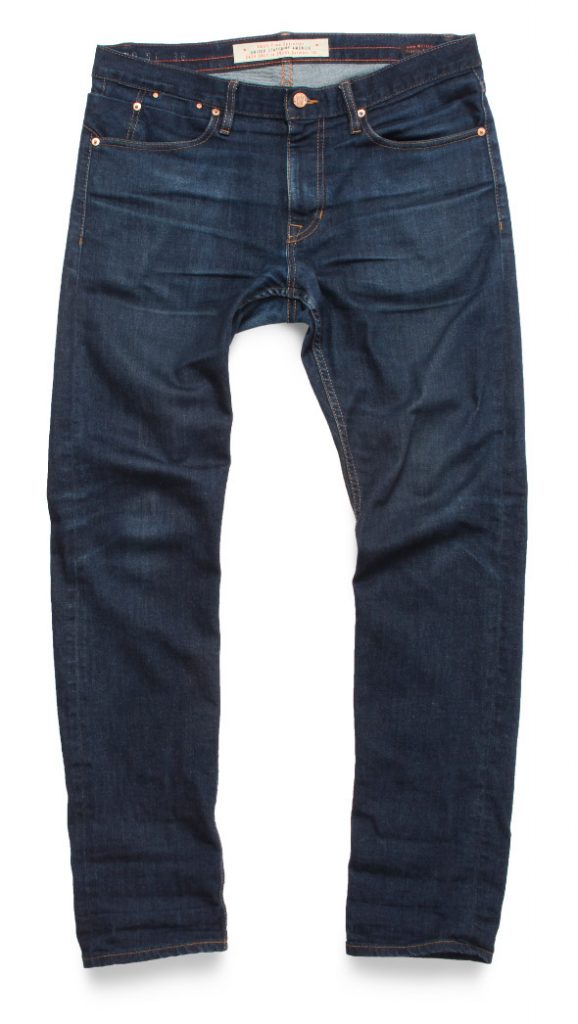
My findings. I now recommend our Hope Street standard raw to people looking for men’s slim-fit jeans that will remain dark for a long time. I recommend either the Grand Street stretch raw jeans or South 4th Street stretch raw jeans in selvedge stretch denim to those seeking comfort and like the idea of raw jeans that doesn’t have to be punished that much to age.
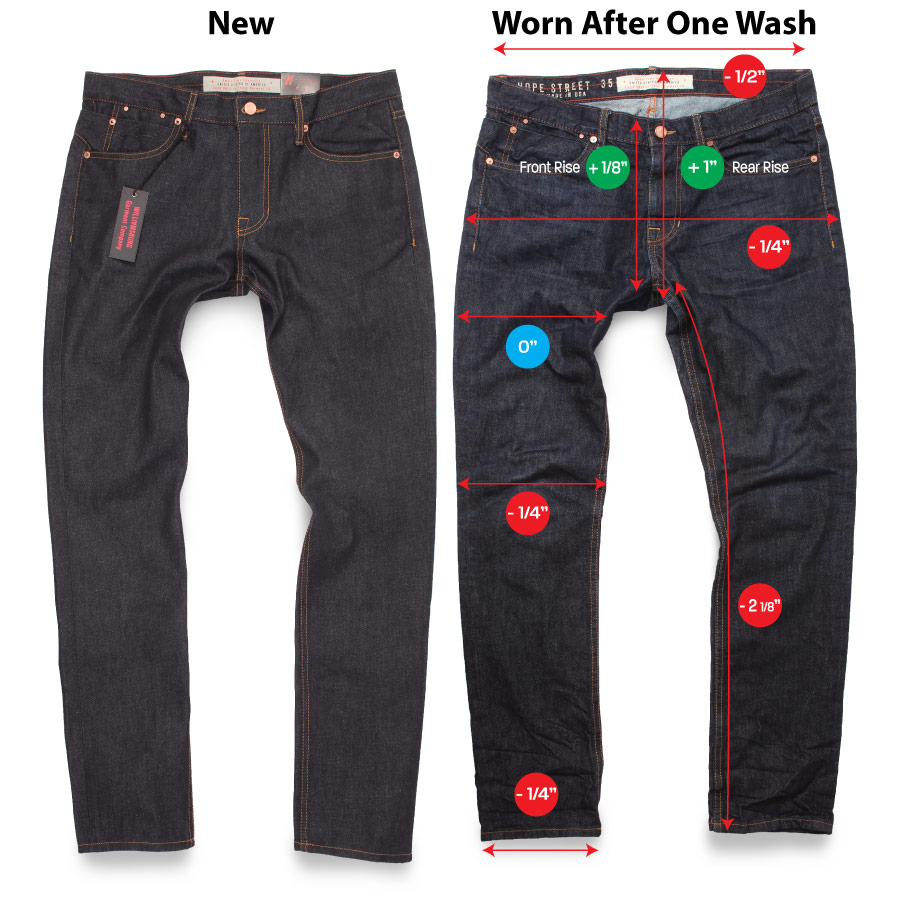
Hope Street questions answered: How much does raw denim shrink and stretch?
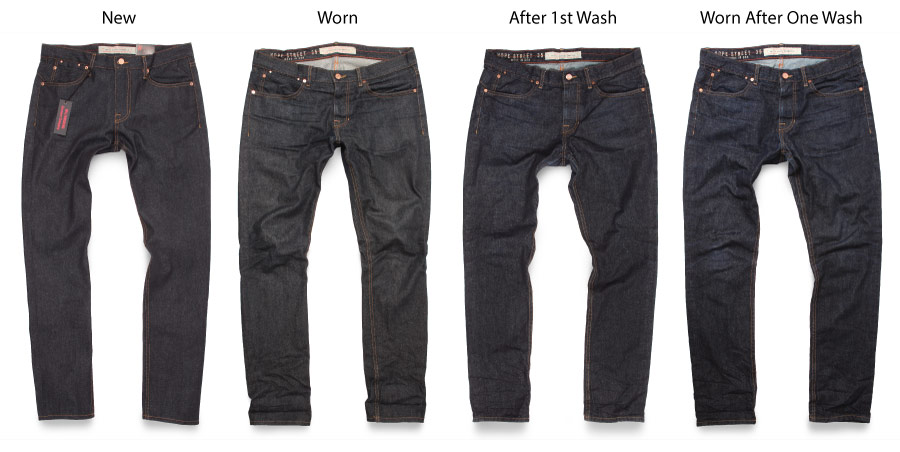
Starting with a fresh new pair of men’s raw denim Hope Street jeans, I recorded measurements of my size 35 jeans. The jeans were worn on average about two days per week for about a year.
One thing I noticed about my Hope Street jeans is they remained very dark even after a year plus of wearing causally and beating them up pretty well in the warehouse. I asked Blake, my sales rep from Cone Denim about this and he told me the denim used in the Hope Street jeans was their darkest pure indigo shade. He went on to say, “it’s 40% pure. That shade is engineered to give the best possible range of shade.” This means that once you do manage to wear the denim down, the multitude of aging tones in the indigo will be beautiful.
Working from the Williamsburg denim store every day, I found myself educating people on things like, “what are selvedge jeans?” Washed vs. raw jeans and how much does raw denim shrink and stretch. The expansion experienced while wearing raw denim jeans and the shrinkage that occurs after washing has been the most challenging conversations. To aid and give visuals to the discussion, I made it my goal to personally begin testing every style of Williamsburg jeans for denim shrinkage and growth. Starting with measurements taken from jeans while new and raw, to the point where they grow after months of wear and ending with recording after-wash measurements, followed by after-wash/after-wear measurements.
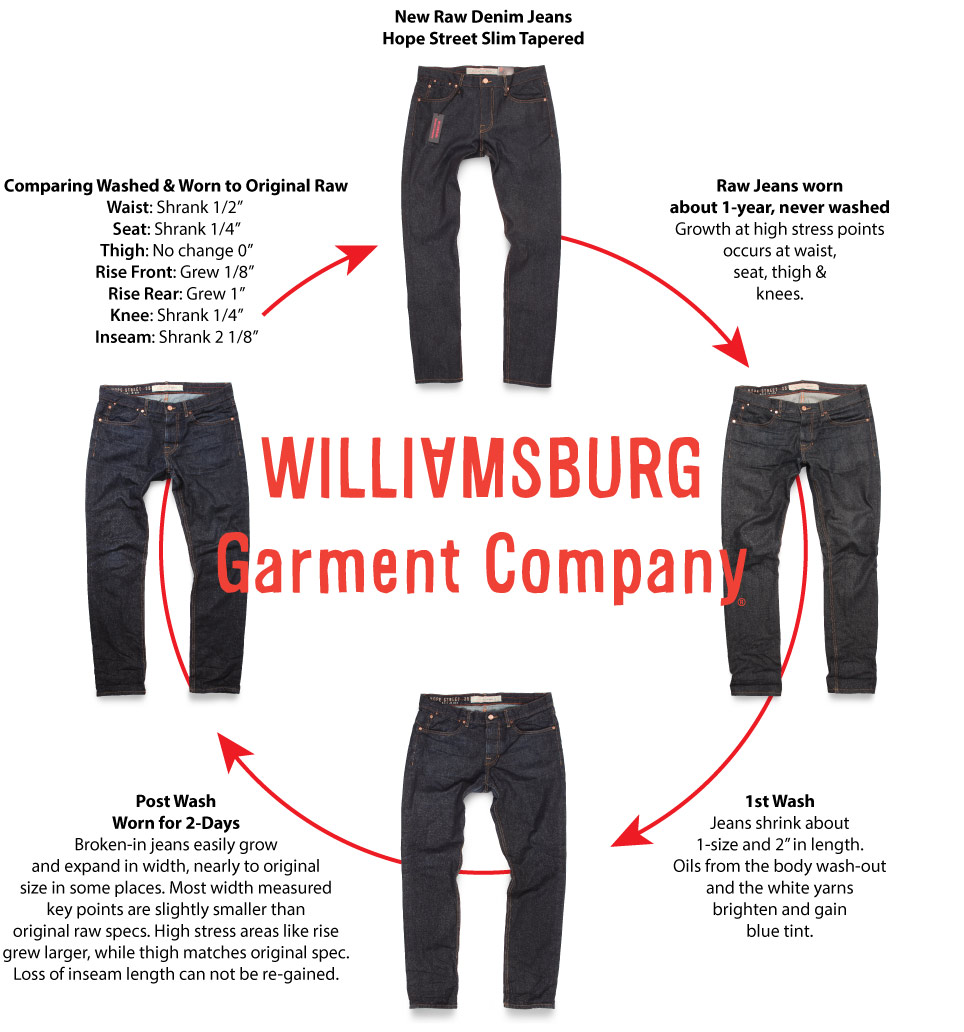
Below, are the measurements from Hope Street, non-stretch, standard raw denim jeans before wear. Followed by the measurements of the jeans after washing and then wearing them for 2 days – stretching and growing the jeans to a size that ends up being slightly smaller jeans than they were in the beginning.
New: Size 35
Waist Band: 39”
Seat: 43 ¾”
Front Rise: 10 ¾”
Rear Rise: 15”
Thigh: 26”
Knee: 17 ¼”
Hem: 14 ½”
Inseam: 35
Washed & Worn: Size 35
Waist Band: 38 ½”
Seat: 43 ½”
Front Rise: 10 ½”
Rear Rise: 16”
Thigh: 26”
Knee: 17”
Hem: 14 ¼”
Inseam: 32 7/8”
In high-stress areas like the waistband, seat, and knees, the denim shrunk a good amount after the first wash. However, after a short time of wear, the fabric expanded relatively with ease. At the rise and thigh, the areas that stretch the most, the changes canceled each other out, growing a great deal while raw, then shrinking and enlarging again shortly after wash and wear. The inseam which sees very little growth during the break-in process is only really affected by shrinkage and loses about 2 inches.
You might be interested in
You may have tried learning through YouTube or social media videos—but when you’re serious about mastering a craft, you quickly
If you’ve ever typed how to take in the waist of jeans into Google, you’ve probably seen a lot of
The first brand in our new lineup was TCB Jeans, a company out of Kojima, Japan that builds its reputation
The leg opening measurement is a critical factor in how your jeans fit over your shoes and shape your overall
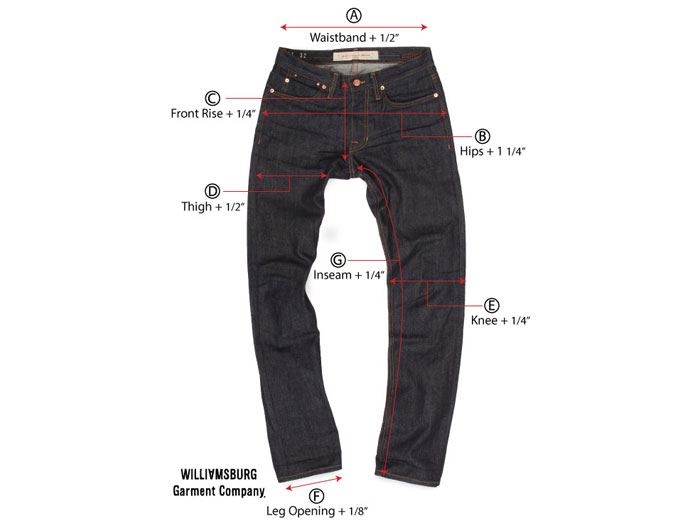
We decided to create this quick guide to answer a common question about breaking in raw denim jeans. One of the most common questions for those looking to buy a pair of raw jeans for the first time is “ How much does raw denim stretch?”
We took measurements from a customer’s jeans after he had worn them for about 2 months and then compared them to the original measurements of the jeans. Here is what we found.
- A. The waistband grew 1/2″ (total circumference)
- B. The hips grew 1 1/4″ (total circumference)
- C. The front rise grew 1/4″
- D. The thigh grew 1/2″ (total circumference)
- E. The knee grew 1/4″ (total circumference)
- F. The leg opening grew 1/8″ (total circumference)
- G. The inseam grew 1/4″
To answer wash and shrinkage questions, earlier experiments of the raw denim jeans in these styles show the shrink rate at 3.5% in width and 2.5% in length.
You might be interested in
You may have tried learning through YouTube or social media videos—but when you’re serious about mastering a craft, you quickly
If you’ve ever typed how to take in the waist of jeans into Google, you’ve probably seen a lot of
The first brand in our new lineup was TCB Jeans, a company out of Kojima, Japan that builds its reputation
The leg opening measurement is a critical factor in how your jeans fit over your shoes and shape your overall

